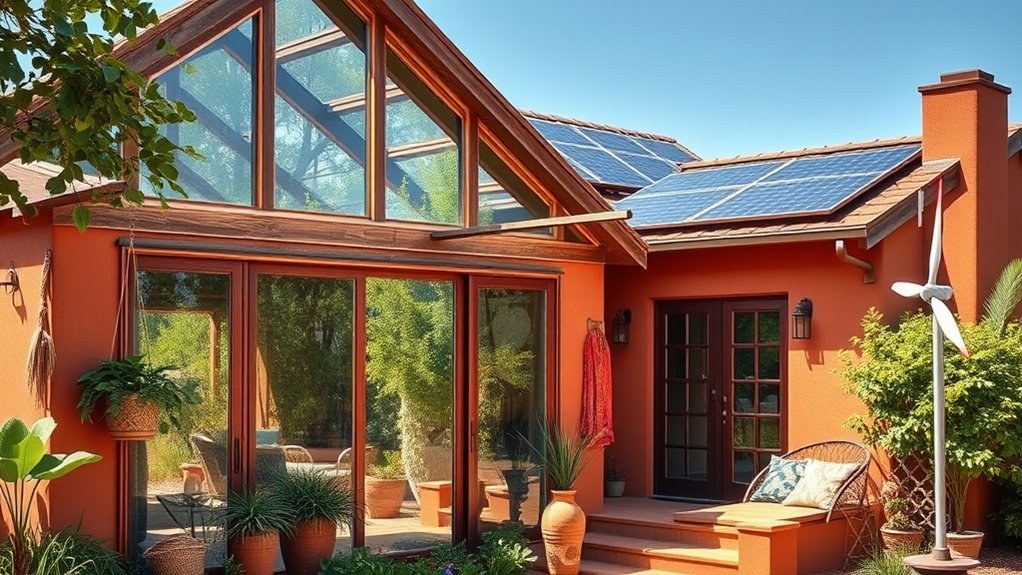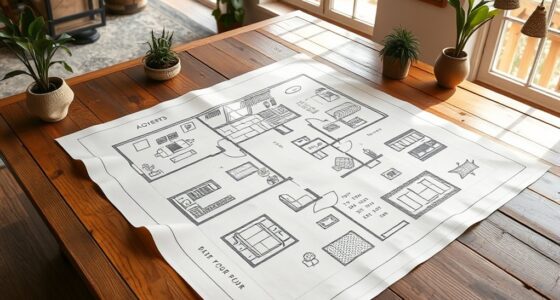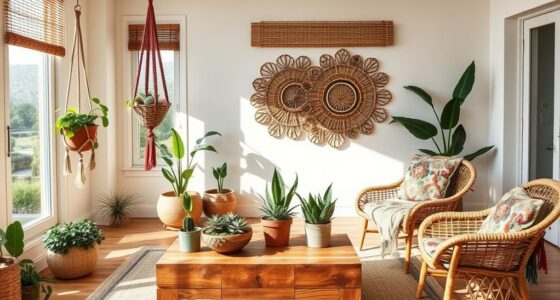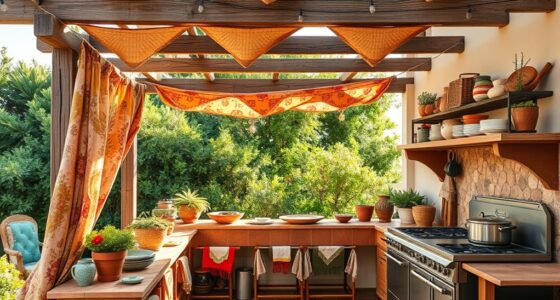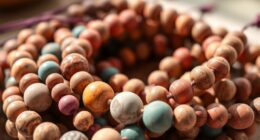Energy-efficient boho homes combine sustainable materials like reclaimed wood and natural fibers with relaxed, stylish designs. You can optimize thermal comfort by choosing eco-friendly finishes, strategic window placement, and advanced insulation. Incorporating passive solar principles and energy-efficient windows helps reduce heating and cooling needs. Solar panels and ventilation systems further cut energy use while improving air quality. To create a cozy, eco-minded space that’s both functional and beautiful, there’s more to explore below.
Key Takeaways
- Incorporate reclaimed wood and natural fibers for eco-friendly, warm, and textured boho interior finishes.
- Use strategic window placement and passive solar design to maximize natural light and reduce heating and cooling needs.
- Install energy-efficient double or triple-glazed windows combined with advanced insulation techniques to enhance thermal performance.
- Integrate solar panels and heat recovery ventilation systems to generate clean energy and improve indoor air quality sustainably.
- Design open, airy layouts that promote natural airflow and daylight, minimizing reliance on artificial lighting and climate control.
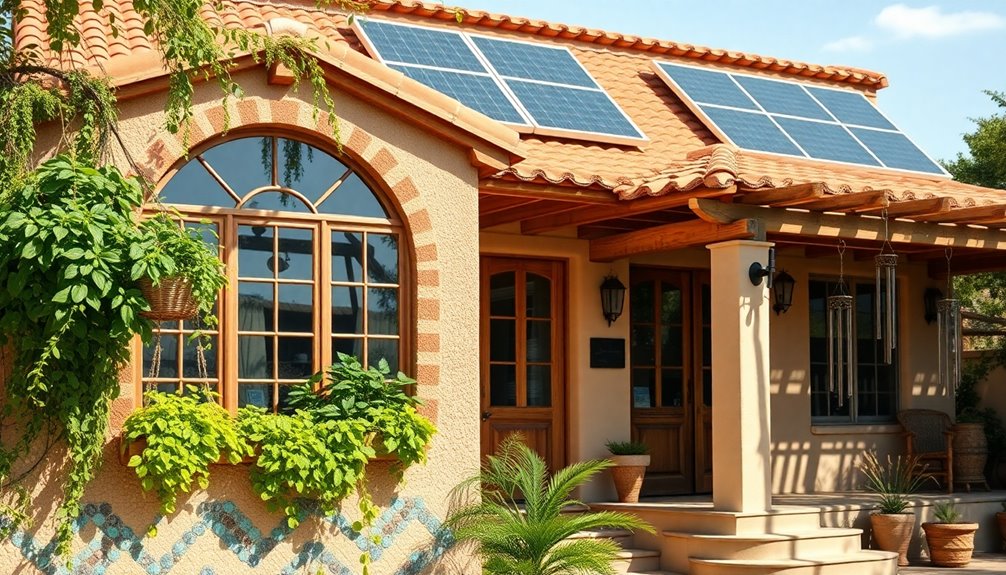
Energy-efficient Boho homes blend sustainable design with relaxed, artistic aesthetics to create spaces that are both beautiful and eco-friendly. When you choose reclaimed wood and natural fibers, you’re incorporating materials that reduce environmental impact while adding warmth and texture to your space. These sustainable materials not only look great but also contribute to a healthier home environment by avoiding toxic chemicals often found in conventional finishes.
Energy-efficient Boho homes use reclaimed materials and natural fibers for sustainable, stylish living.
Eco-friendly finishes like low-VOC paints and natural oils further enhance indoor air quality, ensuring your living space remains fresh and safe.
To maximize energy efficiency, these homes feature advanced insulation techniques such as structural insulated panels and expertly installed insulation that minimize heat transfer. Energy-efficient windows, often double or triple-glazed, are strategically placed to harness passive solar design principles.
This means you’ll benefit from natural sunlight warming your home during winter while avoiding excess heat in summer, reducing your reliance on artificial heating and cooling. The placement and size of windows are carefully considered to improve thermal comfort and optimize daylight while maintaining privacy and aesthetic appeal.
Passive solar design plays a crucial role in these homes. By orienting the structure to capture the sun’s rays and using shading devices, you can naturally regulate indoor temperatures. Combined with insulation techniques, this approach helps maintain a consistent, comfortable climate year-round without excessive energy use.
When additional climate control is necessary, ductless mini-split HVAC systems provide efficient heating and cooling without significant energy consumption. These systems work seamlessly to keep your home comfortable while conserving power.
Solar power integration is common in energy-efficient Boho homes. Installing solar panels allows you to generate your own clean energy, reducing dependence on fossil fuels and lowering utility bills.
Many homes also incorporate heat recovery ventilation systems, which bring in fresh outdoor air while recovering heat from exhausted air, ensuring excellent indoor air quality without wasting energy. This setup creates a balanced environment where fresh air circulates efficiently, and thermal comfort is maintained without drafts or uneven temperatures.
Open layouts and strategic window placement are key design choices that maximize natural light and airflow. The result is a bright, airy space that feels connected to the outdoors.
This not only enhances the aesthetic appeal but also reduces the need for artificial lighting and mechanical cooling. Additionally, understanding relationships and communication can help homeowners better coordinate with builders and designers to create a cohesive and functional environment. Ultimately, your energy-efficient Boho home becomes a sanctuary that celebrates sustainable materials, innovative insulation, and thoughtful design—delivering comfort, beauty, and eco-conscious living all in one.
Frequently Asked Questions
What Are the Most Energy-Efficient Homes?
You’re asking what the most energy-efficient homes are. These homes use advanced insulation like SIPs and spray foam to reduce heat loss. They incorporate renewable energy sources like solar panels and feature high-performance windows with low-E coatings.
They also utilize energy-saving HVAC systems such as ductless mini-split heat pumps. Additionally, they incorporate smart home technology like automated lighting and energy monitors.
Together, these elements help you save energy and lower utility bills effectively.
How Energy-Efficient Are Tiny Homes?
You might wonder how energy-efficient tiny homes really are. These homes typically use insulation like structural insulated panels and high-performance windows to reduce heat loss.
Ductless mini-split heat pumps provide efficient heating and cooling, and natural materials like reclaimed wood boost sustainability.
With passive design features like strategic window placement, you’ll likely enjoy lower energy bills and less environmental impact, making tiny homes a smart, eco-friendly choice.
What Materials Are Used in Bohemian Interior?
You’ll find that bohemian interiors use a mix of natural and sustainable materials. Rattan, reclaimed wood, jute, and linen create a warm, earthy feel.
While organic cotton, hemp, and recycled fabrics add eco-friendly touches. Handcrafted decor like macramé and woven baskets enhance the boho vibe.
Plus, plants in terracotta pots or bamboo planters bring life and organic beauty, making your space both stylish and eco-conscious.
Do Energy-Efficient Homes Cost More?
Think of building a home like planting a garden. You might spend more initially on quality seeds and tools, but you’ll enjoy a richer harvest later.
Similarly, energy-efficient homes cost more upfront because of better insulation and eco-friendly materials. However, these investments pay off over time with lower energy bills, less maintenance, and increased value.
Conclusion
Imagine your boho home as a cozy, green oasis in a bustling city. By embracing energy-efficient design, you’re not just saving money—you’re nurturing a space that breathes with life and sustainability. Every eco-friendly choice adds a brushstroke to your personal masterpiece, creating a sanctuary that’s as beautiful inside as it is kind to the planet. With each step, you turn your home into a vibrant garden of comfort and conscience, blooming brighter with every sustainable choice.

